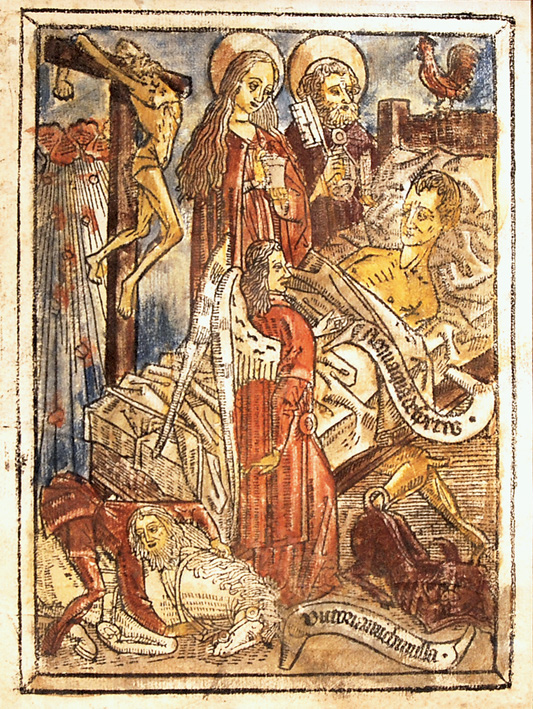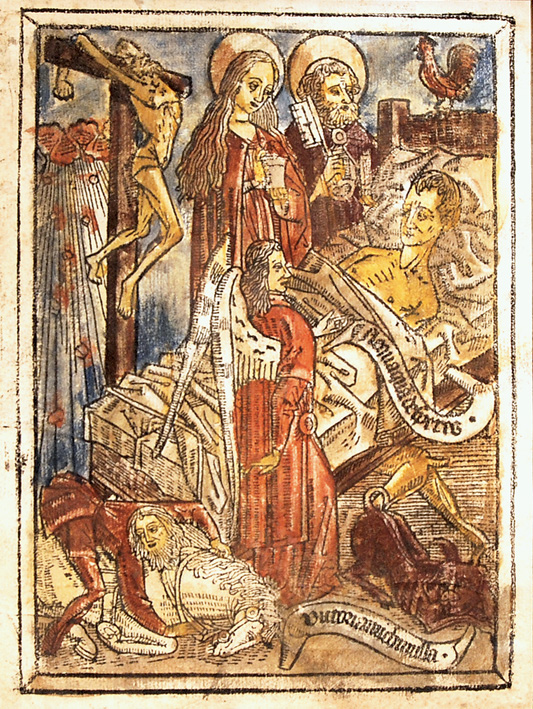
Inspiration Against Despair
This is one of our most exciting recent purchases, a hand-coloured leaf from a fifteenth-century block book known as the Ars Moriendi (The Art of Dying).
Book technology and the transition between script and print are special interests of mine, so I was enthusiastic when this item arrived at the shop. My modern literature colleague challenged me to explain was so special about it, and the first thing that came to mind was:
“It’s the Betamax of printing.”
I know. Comparing a fifteenth-century book to a defunct home video technology from the era of leotards and big hair is a bit underwhelming. But they’re both part of a long tradition of semi-failed innovations that are interesting for what they can tell us about the history of technological development. In the case of Betamax, social, legal, and technological issues made the system obsolete nearly as soon as it got off the ground, giving the advantage to the rival VHS format, but leaving a legacy that is still useful in understanding the ways innovation occurs. Likewise, the lasting value of block books rests in what they can tell us about printing and the consumption of texts during the late middle ages.
Block books were a sideline in the world of early printing, appearing concurrently with Gutenberg’s invention in the 1450s and 60s. Movable type and the printing press had their origins in metalworking and wine pressing. Block books, on the other hand, developed from the use of wood engravings to cheaply and quickly print fabrics, devotional items, and playing cards. Each block book was composed of individual prints that were produced by rubbing a wood engraving against paper, and they were often hand-coloured. What little text was included was usually incorporated directly into the engraving, a delicate and time-consuming process, but worthwhile because the prints could be mass produced without the capital outlay required for type.
Most block books were simplified versions of older texts that had circulated as manuscripts. The Ars Moriendi is a guide to dying righteously by avoiding sins such as despair, pride and impatience on the deathbed. It’s images are first recorded in a manuscript from the 1420s (today held at the Welcome Library), which were later engraved by an anonymous artisan from the upper Rhine. Several versions exist, and our example is particularly rare as it is one of only two leaves known to survive from this edition. The illustration on this particular leaf is the ninth in a series of eleven, showing the dying man protected from despair by visions of the crucifixion, Mary Magdalene, and Saint Peter. Other illustrations from the same series depict demons clamoring for control of the man’s soul.
Like this one, most block books were religious and didactic in nature. The popular Danse Macabre image cycle, which depicts death taking people from different ranks of life, appeared frequently in manuscripts and artwork and also became a block book. The Apoclyapse of John was adapted as a block book, as was the entire Bible, compressed into about 40 engraved pages known as the Biblia Pauperum, or the Poor Man’s Bible. The only block book without images was a version of the popular Latin grammar of Donatus.
What was the audience for books of this nature? Block books were ephemeral items and few have survived, so we have less evidence for their use than we do for other types of texts. But it’s reasonable to assume that the were produced for a popular audience, and the centrality of images over text indicates that they would have been accessible even to those with low literacy skills. They certainly had religious and educational intentions, but it’s likely that people also enjoyed the vivid images for their own sake, and the leaves could conceivably have been separated and displayed.
Block books were produced in significant quantities for only a few decades, with most printed in northern Europe during the 1460s. Their numbers diminished significantly in the latter decades of the century, replaced by growing numbers of books, pamphlets and broadsides that combined movable type with woodcuts. Blockbooks had a short lifespan, but they are important as an indicator of the period’s demand for texts. Far from the stereotypical image of ignorant dark age peasants, medieval laypeople were interested in using and owning books for the same reasons that we are – for education, entertainment, and as marks of social status. Blockbooks were a way that the middle and lower classes could participate in the expansion of book culture during the period when printed texts were still largely out of their reach.





